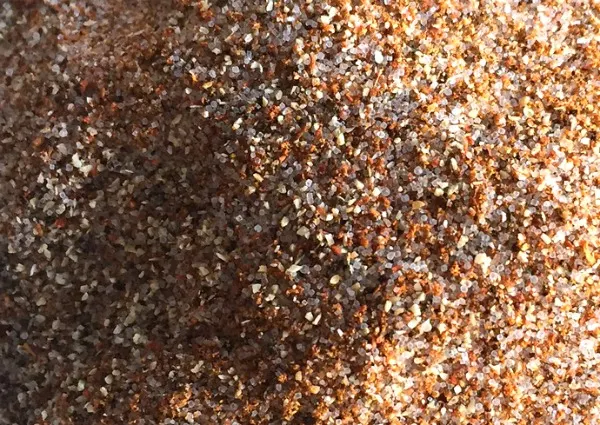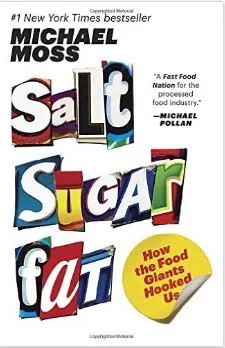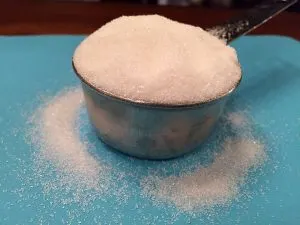There’s a certain irony in writing about Michael Moss’ Salt Sugar Fat on the very day I come home from the store with a shopping cart full of dairy, but here goes anyway…! In all honesty, this book took me weeks to finish. It’s a fascinating topic and Salt Sugar Fat is very well written, but there’s a lot to unpack here — I ended up checking it out of the library more than once before I was able to get through the whole thing.
Salt Sugar Fat delves into the history of the processed food industry in the United States and the three pillars on which it depends — namely, of course, all of that salt, sugar, and fat you find in most packaged food products. Along the way we learn a lot about the science that goes into making processed foods, the marketing decisions that affect their sales, and the relationship between processed food and the obesity epidemic in this country. What sets Salt Sugar Fat apart from many other titles in the genre is its meticulous research and extensive interviews with industry insiders. I can only touch on a few of his points here, but the entire book is well worth reading if you’re interested in how commercial food production got to its current point.
Sugar
I originally picked up Salt Sugar Fat because of my efforts to avoid refined sugar in 2017. As this has forced me to pay more attention to food labeling (and to eat much fewer processed foods in general), it’s fascinating to see how and why the processed food industry as a whole has come to depend on sugar in so many foods. Salt Sugar Fat delves into the ways in which sugar interacts with salt and fat in food products, both to replace some of the taste that processed foods would otherwise lack (and even to cover up unpleasant tastes!), and to encourage people to eat ever more of these products (and even to eat ever more in general).
Moss launches the book by talking about sugar’s role in processed foods and discussing people’s “bliss point” for sugar: AKA, the exact amount of sweetness that makes a food or beverage most enjoyable. When companies hit the right note here, they’re able to sell more products , but when consumers perceive a product as being either too sweet or not sweet enough, they’ll instead buy more of a competitor’s product — and no one at the big food companies want that. Unsurprisingly, children tend to have a higher “bliss point” and prefer more intense levels of sweetness than adults, which is why you see children’s cereals, yogurts, and other products that are so high in added sugar. Food companies argue here that they’re giving consumers what they want to buy, but critics argue that this level of sweetness in products aimed at children actually teaches them how things should taste and increases their preference for sweeter products across the board.
(Anecdotally, I find a lot of truth in this point of view. Since I started avoiding refined sugar about six weeks ago, I find that food tastes different to me than it used to: Fruit, especially, tastes sweeter, and I don’t crave the same sorts of processed desserts and candy that I used to.)
Fat
But fat lacks the same sort of “bliss point” as sugar: Moss delves into experiments showing that increasing the richness of food doesn’t send the same sort of “stop” signals as sugar does when it gets beyond a certain level: Test subjects can taste added sugar but can’t identify added fat content. Unless people see what we visually think of as fat, they don’t necessarily think of foods as fatty. Not only that, adding sugar on top of fat makes fattier foods taste even better, giving food manufacturers a double whammy.
Salt

The last section of Salt Sugar Fat delves into the role of salt in processed food. Any home cook knows the power of just a little salt in bringing out and brightening up the other flavors in a dish — but commercial food production takes this to another dimension altogether. More than three quarters of the salt people consume in a week tends to come from processed foods, and a look at almost any label (from soup to crackers to TV dinners) will show you why.
Salt also has the magical ability to mask unpleasant flavors in foods, such as that of reheated pre-cooked meat in soups and boxed meals. At a bulk cost of about 10 cents a pound, it’s much cheaper to add more salt than to add herbs to enhance the flavors of (and hide unpleasant flavors in) packaged foods. Just as with sugar, salt also comes in multiple names and multiple forms, often appearing multiple times in the ingredient list of a single product. Moss describes a taste testing session where, for example, he’s treated to salt-free versions of iconic foods from Cheez-Its for Corn Flakes to Eggo waffles — all of which were terrible in terms of taste, texture, and appearance. Eliminating or even reducing salt can change the whole flavor profile of a product.
Along the way
Throughout Salt Sugar Fat you’ll also be treated to stories that highlight pivotal points in the history of processed food — from the industry response to public concern about sugar, to the power of Big Beef and Big Dairy in the conversation about fat, to the creation and marketing of the Lunchable. Moss describes meetings, marketing campaigns, and products throughout the years that show how the food industry’s responsibility to its investors and shareholders has affected its decisions at every turn, but always comes back to the salt, sugar, fat that give processed foods their allure. I’m not sure whether I’m more fascinated or horrified, but it’s definitely an interesting and thought-provoking read.
What are you reading this week?
What have you been reading lately? Tell us about it! 🙂 — and you can browse all the What’s Rachel Reading? book reviews here.




Christian
Saturday 4th of February 2017
Not much time to read these days, but plenty of visual media (and plenty of controversy) to otherwise supplement such topics. I don't think there's any question to the ill effects of too much sugar. Watched "That Sugar Film" (it's on Amazon Prime) a while back... I think they spoke with the gentleman who invented the "bliss point" (for one of the cola companies), and he seemed to be proud of the accomplishment, lol. Regardless, it's definitely scary stuff...
Anne
Friday 3rd of February 2017
I also read Salt Sugar Fat a while back. It definitely changed the way I looked at processed foods, knowing how highly engineered they really are. I have been trying to get through Pillars of the Earth. Definitely a good read, but have been working on it a month already and am ready to move onto something else!